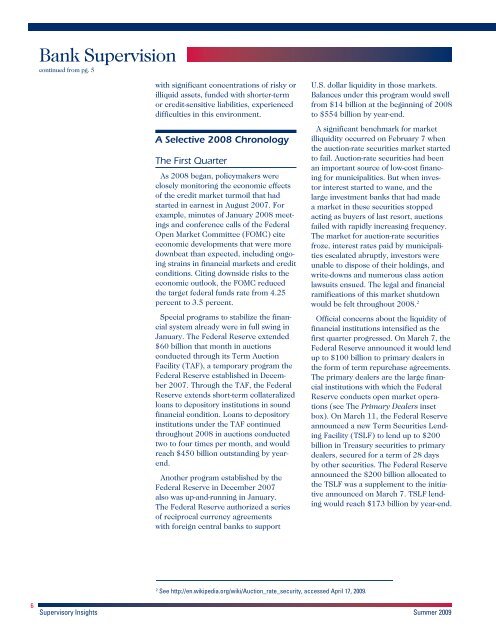FDIC Supervisory Insights Summer 2009
FDIC Supervisory Insights Summer 2009
FDIC Supervisory Insights Summer 2009
You also want an ePaper? Increase the reach of your titles
YUMPU automatically turns print PDFs into web optimized ePapers that Google loves.
Bank Supervision<br />
continued from pg. 5<br />
with significant concentrations of risky or<br />
illiquid assets, funded with shorter-term<br />
or credit-sensitive liabilities, experienced<br />
difficulties in this environment.<br />
A Selective 2008 Chronology<br />
The First Quarter<br />
As 2008 began, policymakers were<br />
closely monitoring the economic effects<br />
of the credit market turmoil that had<br />
started in earnest in August 2007. For<br />
example, minutes of January 2008 meetings<br />
and conference calls of the Federal<br />
Open Market Committee (FOMC) cite<br />
economic developments that were more<br />
downbeat than expected, including ongoing<br />
strains in financial markets and credit<br />
conditions. Citing downside risks to the<br />
economic outlook, the FOMC reduced<br />
the target federal funds rate from 4.25<br />
percent to 3.5 percent.<br />
Special programs to stabilize the financial<br />
system already were in full swing in<br />
January. The Federal Reserve extended<br />
$60 billion that month in auctions<br />
conducted through its Term Auction<br />
Facility (TAF), a temporary program the<br />
Federal Reserve established in December<br />
2007. Through the TAF, the Federal<br />
Reserve extends short-term collateralized<br />
loans to depository institutions in sound<br />
financial condition. Loans to depository<br />
institutions under the TAF continued<br />
throughout 2008 in auctions conducted<br />
two to four times per month, and would<br />
reach $450 billion outstanding by yearend.<br />
Another program established by the<br />
Federal Reserve in December 2007<br />
also was up-and-running in January.<br />
The Federal Reserve authorized a series<br />
of reciprocal currency agreements<br />
with foreign central banks to support<br />
2 See http://en.wikipedia.org/wiki/Auction_rate_security, accessed April 17, <strong>2009</strong>.<br />
U.S. dollar liquidity in those markets.<br />
Balances under this program would swell<br />
from $14 billion at the beginning of 2008<br />
to $554 billion by year-end.<br />
A significant benchmark for market<br />
illiquidity occurred on February 7 when<br />
the auction-rate securities market started<br />
to fail. Auction-rate securities had been<br />
an important source of low-cost financing<br />
for municipalities. But when investor<br />
interest started to wane, and the<br />
large investment banks that had made<br />
a market in these securities stopped<br />
acting as buyers of last resort, auctions<br />
failed with rapidly increasing frequency.<br />
The market for auction-rate securities<br />
froze, interest rates paid by municipalities<br />
escalated abruptly, investors were<br />
unable to dispose of their holdings, and<br />
write-downs and numerous class action<br />
lawsuits ensued. The legal and financial<br />
ramifications of this market shutdown<br />
would be felt throughout 2008. 2<br />
Official concerns about the liquidity of<br />
financial institutions intensified as the<br />
first quarter progressed. On March 7, the<br />
Federal Reserve announced it would lend<br />
up to $100 billion to primary dealers in<br />
the form of term repurchase agreements.<br />
The primary dealers are the large financial<br />
institutions with which the Federal<br />
Reserve conducts open market operations<br />
(see The Primary Dealers inset<br />
box). On March 11, the Federal Reserve<br />
announced a new Term Securities Lending<br />
Facility (TSLF) to lend up to $200<br />
billion in Treasury securities to primary<br />
dealers, secured for a term of 28 days<br />
by other securities. The Federal Reserve<br />
announced the $200 billion allocated to<br />
the TSLF was a supplement to the initiative<br />
announced on March 7. TSLF lending<br />
would reach $173 billion by year-end.<br />
6 <strong>Supervisory</strong> <strong>Insights</strong> <strong>Summer</strong> <strong>2009</strong>

















